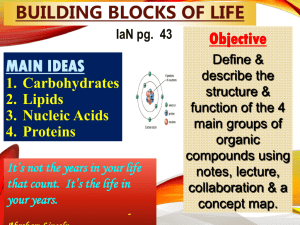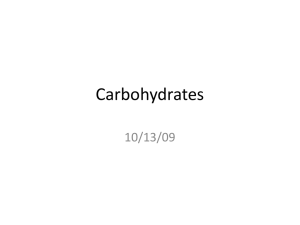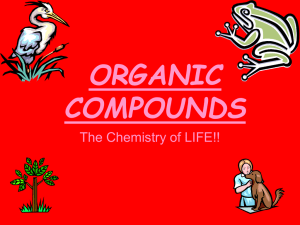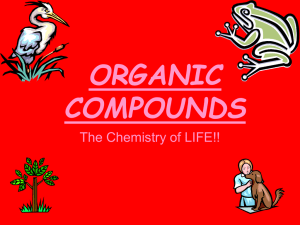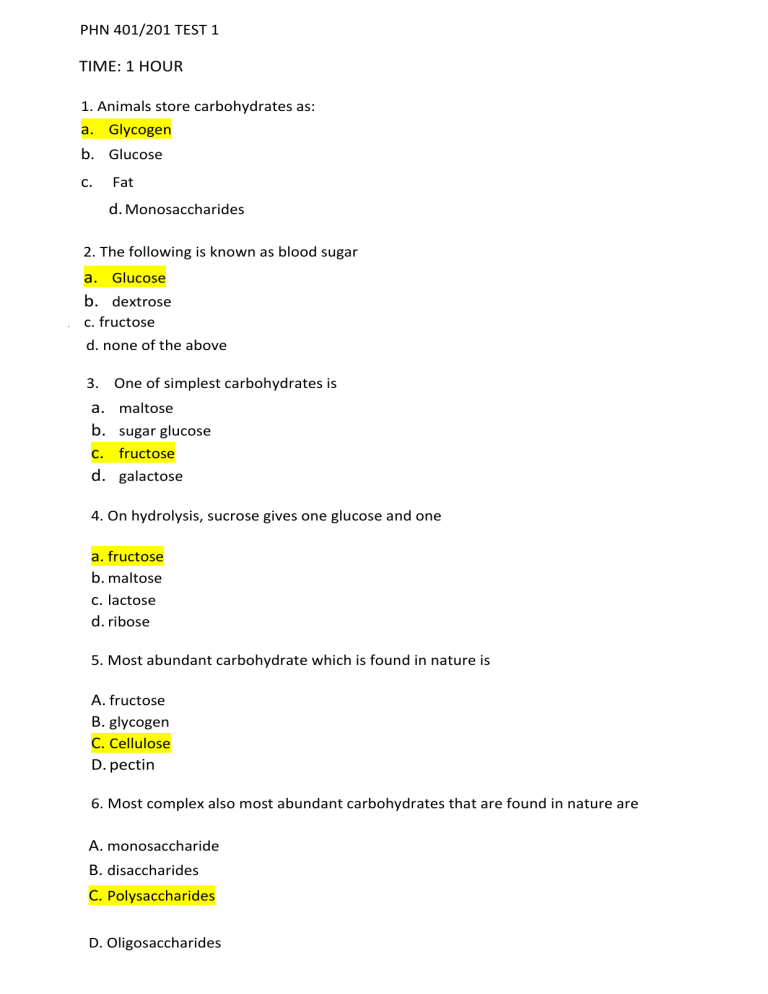
PHN 401/201 TEST 1 TIME: 1 HOUR 1. Animals store carbohydrates as: a. Glycogen b. Glucose c. Fat d. Monosaccharides 2. The following is known as blood sugar a. Glucose b. dextrose c. fructose d. none of the above 3. One of simplest carbohydrates is a. b. c. d. maltose sugar glucose fructose galactose 4. On hydrolysis, sucrose gives one glucose and one a. fructose b. maltose c. lactose d. ribose 5. Most abundant carbohydrate which is found in nature is A. fructose B. glycogen C. Cellulose D. pectin 6. Most complex also most abundant carbohydrates that are found in nature are A. monosaccharide B. disaccharides C. Polysaccharides D. Oligosaccharides 7. Vitamin A is A. Retinol B. Carotenoid C. Antioxidant D. None of the above 8. The sugar found in DNA is a. Ribose b. Xylose c. deoxyribose d. Ribulose 9. Hydrolysis of lactose yields a. galactose and fructose b. galactose and glucose c. glucose and fructose d. fructose and galactose 10. Which of the following is called table sugar? a. b. c. d. Glucose Sucrose Lactose fructose 11. Natural lipids are readily soluble in a. b. c. d. oil mercury water none of the above 12. Which of the following is/are unsaturated fatty acids a. Linoleic acid b. Oleic acid c. Palmitoleic acid d. All of these 13. Which is a phospholipid a. Lecithin b. Cholesterol c. Sterol 14. Essential fatty acids are a. Linoleic acid b. Arachidonic acid c. Linolenic acid d. All of these 15. The lipid that is a component of the plasma membrane and can be used to form bite salts and steroid hormones is a. a saturated fat. b. an unsaturated fat c. triglyceride d. cholesterol. 16. The proteins in the body are composed of 20 amino acids; 9 of these amino acids arc termed essential amino acids. a.20:9 b.20; 11 c.40; 20 d.40; 9 D. a phospholipid. 17. Organic molecules found in minute quantities in food but that are essential to normal metabolism are called a. coenzymes. b. provitamins. c. nonessential vitamins. d. Vitamins 18. Which one of the following vitamin remains in the body for only a short time before being excreted? a. A b. K c. C d. D 19. One of the reported benefits of taking Vitamin C and Vitamin E is that they a. increase the formation of collagen. b. promote the absorption of calcium and phosphorus from the small intestine. c. are necessary for rhodopsin synthesis in the retina. d. block the effect of free radicals 20. Inorganic nutrients that are necessary for normal metabolism are called a. b. c. d. minerals. vitamins. lecithin. eicosanoids. 21. Give the names of the protein structures. Primary,secondary,Tertially and Quanternary 22. Name the stages of protein formation. Transcription,transformation,protein folding 23. Name 4 micronutrients of public health in Zambia. Vitamin A,iron,iodine,folic acid 24. Name the categories of nutritional interventions under scaling up nutrition Nutritionspecific interventions and Nutrition-sensitive interventions 25. Give 2 examples from each intervention mentioned in question 24 Nutrition-specific interventions • • • • • • • • Iron and Folic Acid Supplementation Promotion of optimal breastfeeding Optimal complementary feeding Diverse diets for pregnant and lactating women Zinc supplementation Growth monitoring and promotion Vitamin A supplementation and deworming Integrated Management of Acute Malnutrition Nutrition-sensitive interventions • • • • Promotion of safe water, sanitation and hygiene Promotion of diverse diets through promoting growing of various food crops Promotion of diverse diets with regards to fish and livestock Promotion of increased availability of diverse locally available and Processed foods (with focus on women’s empowerment) • Nutritional sensitive messages in GRZ programmes (FISP, SHN) 26.Name 3 types of malnutrition which the scaling up nutrition is trying to combat wasting,stanting and under weight 27. A condition were red blood cells appear bigger than normal is called megaloblastic anemia 28. Lack of folate in early pregnancy can lead to a condition known as neural tube defect 29. The eye pigment is called heterochromia 30.At room temperature, lipids are known as 31. fats or oils Unsaturated Fatty acids are good for health 32. Triglycerides are made up of fatty acids and glycerol 33. Osteoporosis results from vitamin D deficiency 34. Iodine deficiency can lead to birth of a child with physical and neurological impairment known as cretinism
